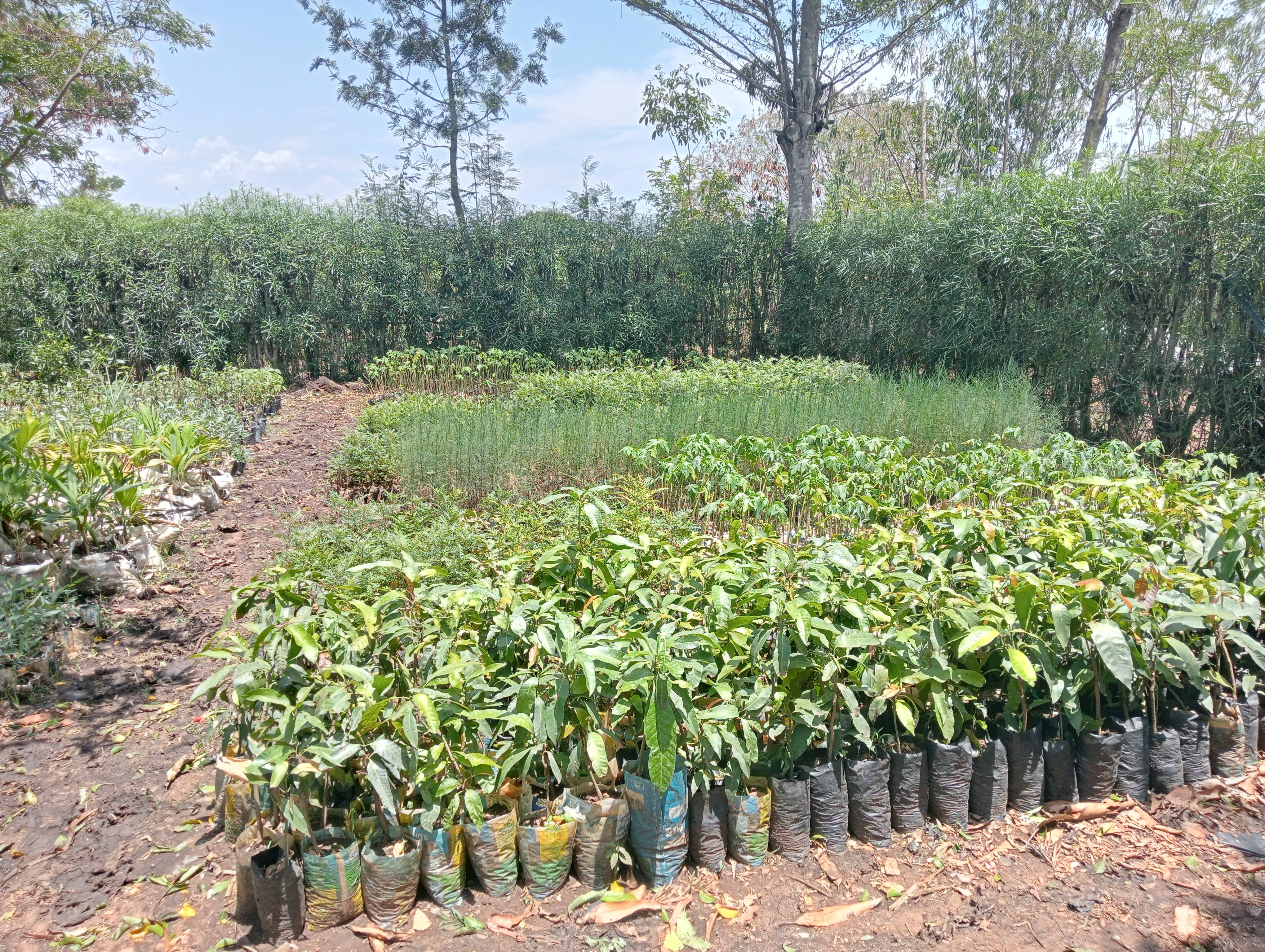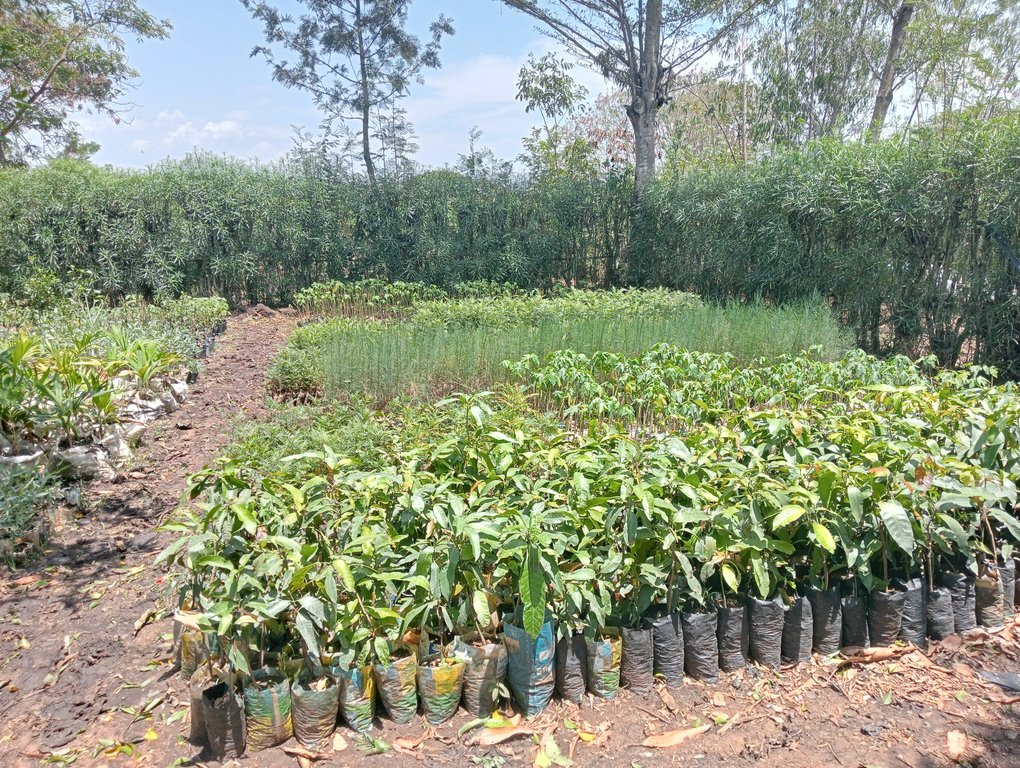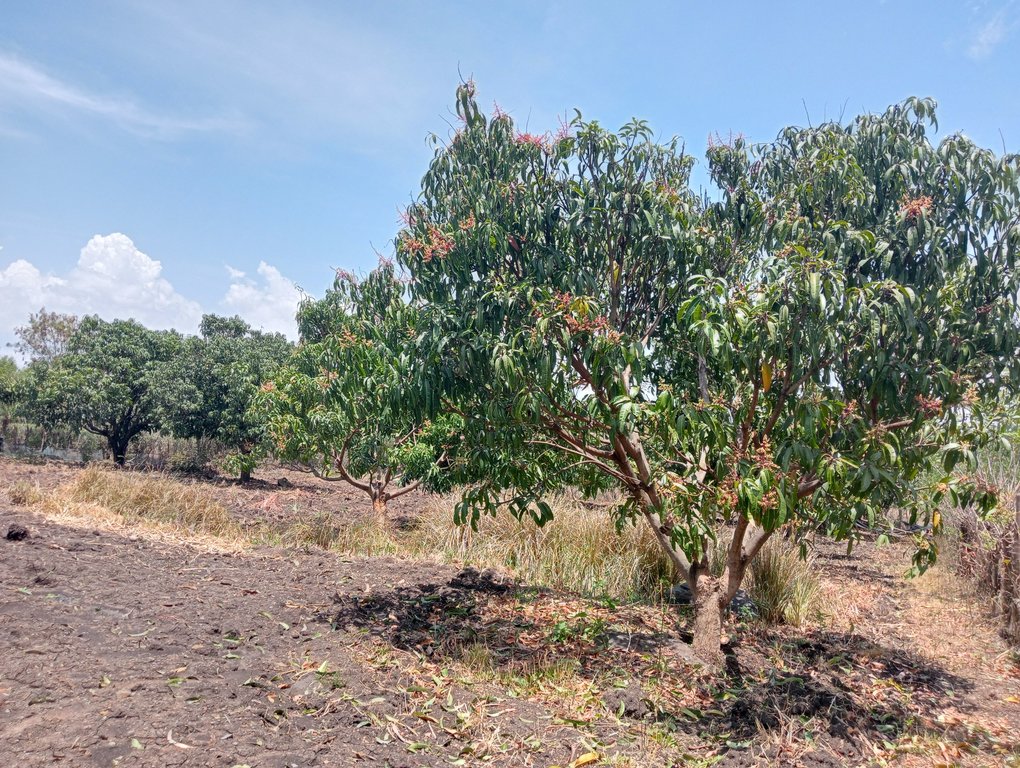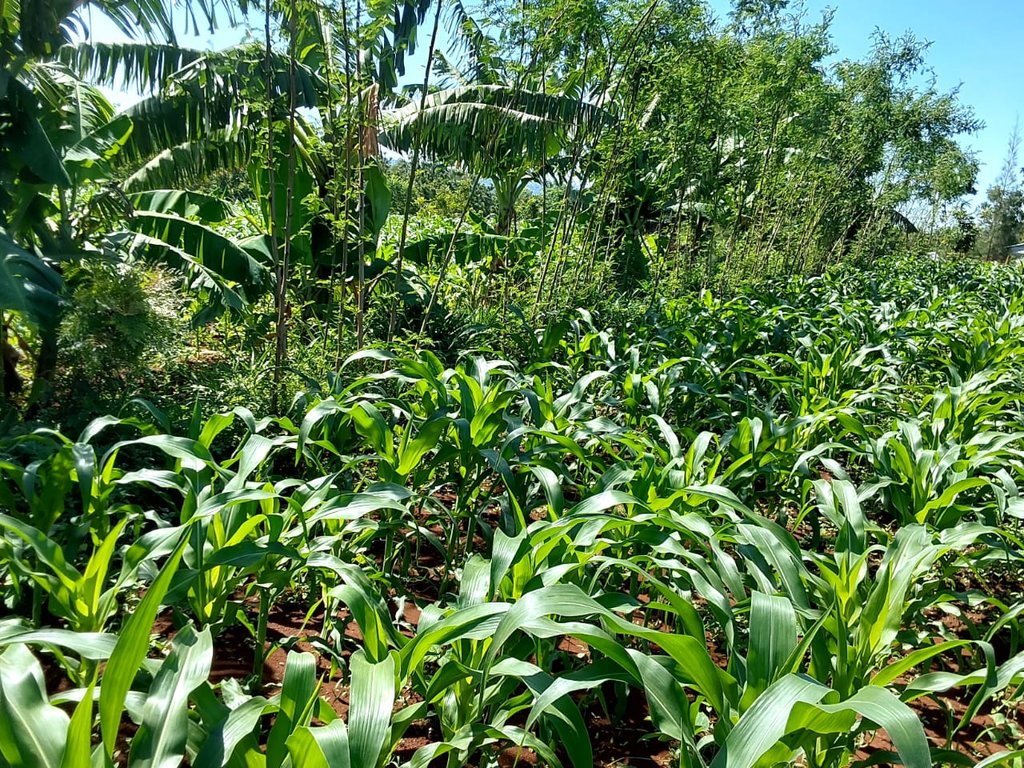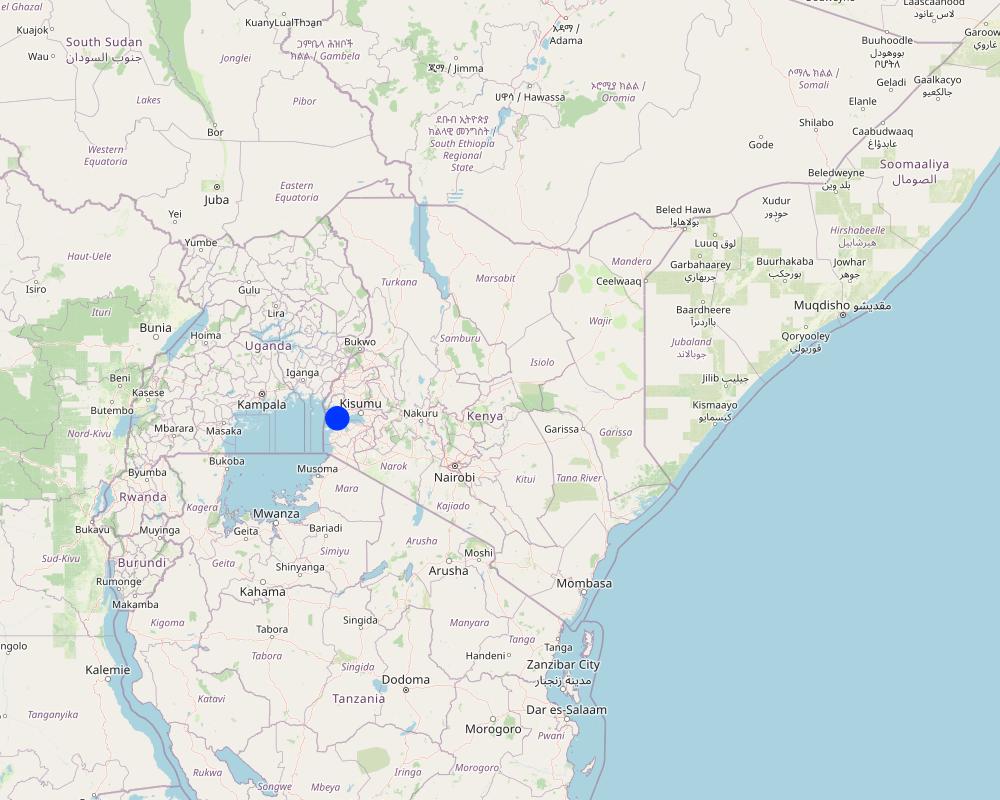Promotion of different trees for agroforestry [Kenia]
- Creación:
- Actualización:
- Compilador: William Akwanyi
- Editores: JARED AYIENA, Innocent Faith, Noel Templer, JUSTINE OTSYULA, Tabitha Nekesa, Ahmadou Gaye, Siagbé Golli
- Revisores: William Critchley, Rima Mekdaschi Studer, Sally Bunning
approaches_6706 - Kenia
Visualizar secciones
Expandir todo Colapsar todos1. Información general
1.2 Detalles de contacto de las personas de referencia e instituciones involucradas en la evaluación y la documentación del Enfoque
Persona(s) de referencia clave/s
Usuario de la tierra:
Omolo Charles Abok
+254 728 135152
charlesabok88@gmail.com
Welthungerhilfe farmer
Village of Nyaguda, South Sakwa ward, Bondo Sub-county, Siaya County
Kenia
Especialista MST:
Especialista MST:
Nombre del proyecto que facilitó la documentación/ evaluación del Enfoque (si fuera relevante)
Soil protection and rehabilitation for food security (ProSo(i)l)Nombre de la(s) institución(es) que facilitaron la documentación/ evaluación del Enfoque si fuera relevante)
Deutsche Gesellschaft für Internationale Zusammenarbeit (GIZ)Nombre de la(s) institución(es) que facilitaron la documentación/ evaluación del Enfoque si fuera relevante)
Alliance Bioversity and International Center for Tropical Agriculture (Alliance Bioversity-CIAT) - Kenia1.3 Condiciones referidas al uso de datos documentados mediante WOCAT
¿Cuándo se compilaron los datos (en el campo)?
01/03/2023
El compilador y la/s persona(s) de referencia claves aceptan las condiciones acerca del uso de los datos documentados mediante WOCAT :
Sí
1.4 Referencia/s al/los Cuestionario(s) de Tecnologías MST
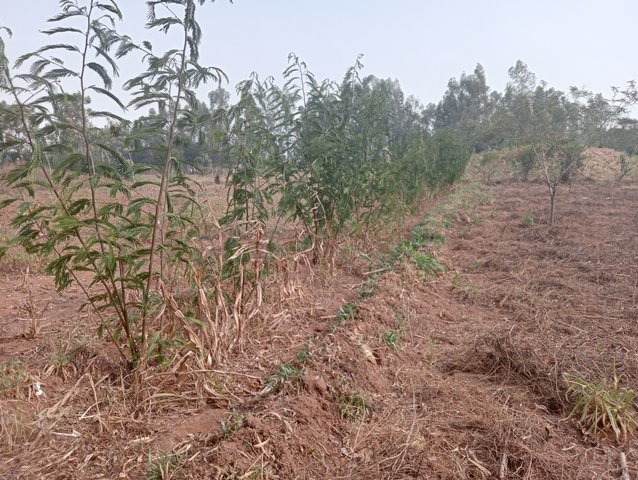
Vegetative cross-slope barriers [Kenia]
Cross-slope barriers in the form of vegetative strips are established on sloping lands to reduce runoff velocity and prevent soil loss, thereby contributing to the conservation of soil, water, and plant nutrients.
- Compilador: William Akwanyi
2. Descripción del Enfoque MST
2.1 Breve descripción del Enfoque
Promoting the values of different trees and their benefits in agroforestry contributes to increased adoption by farmers.
2.2 Descripción detallada del Enfoque MST
Descripción detallada del Enfoque MST:
Agroforestry involves the integration of trees and/ or shrubs in a farming system on the same land where crops or pastures are grown. It offers significant environmental, economic, and social benefits. Agroforestry also enables farmers to diversify their on-farm income. Furthermore, it contributes to climate change adaptation and mitigation and improves the environment within the farm, especially soils. However, not every farmer is willing to adopt agroforestry. Trees and shrubs take up space that would have been dedicated to crops or pasture: this is a primary reason why farmers are not willing to plant trees and/ or shrubs on their farms. Similarly, many farmers do not clearly understand the values of some trees and shrubs. It is, therefore, essential to overcome the barriers to adopting agroforestry among farmers.
The ProSoil project has created awareness among farmers in Kakamega, Bungoma, and Siaya Counties about the more efficient and profitable tree and shrub-based value chains to attract farmers to agroforestry and pave the way for greater uptake. The farmers were targeted through their groups. Each group consisting of about 25 farmers, and with at least 30% women. Farmers are introduced to trees and/ or shrubs that blend well with their farming system. In addition, farmers choose trees and/ or shrubs based on the sizes of their farming land and their respective benefits. Farmers can plant trees and shrubs as single stands or integrate them into farming land. They can also plant agroforestry trees around their homesteads. A single stand can have, for example, mangos, avocados, and/or other trees. The project advocates for a more sustainable win-win approach where farmers and the environment benefit from an agroforestry system. Some of the benefits of trees and shrubs, as highlighted by the project, include the following:
a) Soil erosion control: trees and shrubs are planted on across slopes to slow down runoff and trap sediment (consequently, accumulating soil – this can form terraces after several years). Their roots hold the soil in place and reduce the impact of moving water.
b) Stabilising stream banks and gullies (e.g., Leucaena leucocephala, Sesbania grandiflora, Moringa oleifera, etc.): help to reduce soil erosion along streams and gullies when planted at the medium- to high-level watermark. Their roots hold the soil in place and reduce the impact of moving water.
c) Green manure (e.g., Sesbania sesban, Tithonia sp., etc.): from foliage and twigs.
d) Live fences (e.g., Tithonia sp.): used as boundaries to provide privacy and protection from browsing animals.
e) Windbreakers (e.g., Casuarina equisetifolia, Grevillea robusta, Leucaena leucocephala, etc.): planted in one or two rows/ lines closely together along the edges of the farm and perpendicular to winds to protect crops, soils, and structures from the detrimental effects of wind.
f) Fodder (e.g., Grevillea robusta, Sesbania sesban, Leucaena leucocephala, etc.): foliage is food for livestock.
g) Food (e.g., mangoes, avocadoes, etc.): a human food source.
h) Carbon sequestration (all trees and shrubs): they act as carbon sinks by capturing carbon dioxide from the atmosphere.
2.3 Fotos del Enfoque
2.5 País/ región/ lugares donde el Enfoque fue aplicado
País:
Kenia
Región/ Estado/ Provincia:
Siaya County, Nyanza Region
Especifique más el lugar :
Nyagudha village, South Sakwa Ward, Bondo Sub-county
Map
×2.6 Fechas de inicio y conclusión del Enfoque
Indique año del inicio:
2019
2.7 Tipo de Enfoque
- Both traditional practice and project based: farmers have been growing trees and shrubs on their farms but the ProSoil project introduced them to more beneficial trees and better ways of producing the trees e.g., through grafting.
2.8 Propósitos/ objetivos principales del Enfoque
Aim: To promote the adoption of agroforestry.
Objectives:
1) To introduce farmers to the diverse benefits of trees in farming.
2) To encourage farmers to incorporate trees and/ or shrubs in their farming.
2.9 Condiciones que facilitan o impiden la implementación de la/s Tecnología/s aplicadas bajo el Enfoque
normas y valores sociales/ culturales/ religiosos
- facilitan
Trees play a central role in the socio-cultural lives of people and are used for a wide range of cultural practices.
- impiden
Cultural beliefs: e.g., women are not supposed to plant (some) trees as this is considered a male role. This hinders women from full participation in agroforestry activities.
disponibilidad/ acceso a recursos y servicios financieros
- impiden
Some farmers do not have adequate financial resources to purchase seedling of some tree and shrub seedlings.
colaboración/ coordinación de actores
- facilitan
Other institutions such as the county governments pass agroforestry information to farmers through the public agricultural extension officers. County governments are important collaborators in the ProSoil project.
marco de trabajo legal (tenencia de tierra, derechos de uso de tierra y agua)
- impiden
Trees and/ or shrubs take several years to mature. This is closely linked to land tenure since most people would prefer to establish trees only on their farms.
políticas
- facilitan
Kenya's 10 Percent Tree Cover Strategy includes the component of promoting farm forestry through various platforms e.g., radio and TV.
gobernanza de tierras (toma de decisiones, implementación y aplicación)
- impiden
Women and youth have little or no control over land in most communities. Hence, they cannot make decisions to plant (some) trees on the family land.
conocimiento de MST, acceso a apoyo técnico
- facilitan
ProSoil project has supported the dissemination of information about the importance of agroforestry as an SLM technology and how to propagate trees e.g., through grafting. As a result, some farmers have established trees nurseries.
mercados (para comprar insumos, vender productos) y precios
- facilitan
The increasing awareness about the benefits of many trees has led to an increase in the demand for the different products from the trees e.g., fruits, honey, medicines, etc. This potential of trees to generate income encourages farmers to plant trees.
3. Participación y roles de las partes interesadas involucradas
3.1 Partes interesadas involucradas en el Enfoque y sus roles
- usuarios locales de tierras/ comunidades locales
Farmers, farmer groups (women, youth, and mixed gender)
Recipients of the trainings in agroforestry.
- especialistas MST/consejeros agrícolas
GIZ ProSoil project SLM specialists; specialists from the implementing partner, Welthungerhilfe; and county SLM specialists from the departments of agriculture and environment.
Provides technical advice to the farmers and link farmers to markets and tree nurseries.
- gobierno local
County government agriculture and environment departments
Provides technical advice to the farmers and link farmers to markets and tree nurseries.
- organización internacional
GIZ
Financial support to the technical team and farmers during capacity building.
Si varias partes interesadas estuvieron involucradas, indique la agencia principal:
GIZ
3.2 Involucramiento de los usuarios locales de tierras/ comunidades locales en las distintas fases del Enfoque
| Involucramiento de los usuarios locales de tierras/ comunidades locales | Especifique quién se involucró y describa las actividades | |
|---|---|---|
| iniciación/ motivación | auto-movilización | Farmers involved in the training in agroforestry. |
| planificación | interactivo | Farmers consulted on where and when to establish demos of agroforestry tree nurseries. |
| implementación | auto-movilización | Although farmers are advised which trees are better for their farms, they are the final decision makers on which trees and shrubs to incorporate in their farms. |
| monitoreo y evaluación | pasivo | Interviews with implementing farmers. |
| ninguno |
3.3 Flujograma (si estuviera disponible)
Descripción:
The ProSoil project (GIZ and WHH) provides financial (transport reimbursement) and material (seedlings) support to farmers through their groups (Ndati Development Self-Help Group). The project also facilitates the county departments of Agriculture and Environment to train farmers in agroforestry and increase their awareness about the socio-economic and ecological benefits of different trees. at the farm.
Autor:
William Akwanyi
3.4 La toma de decisiones en la selección de Tecnología(s) MST
Especifique quién decidió la selección de las Tecnología/ Tecnologías a implementarse:
- principalmente usuarios de tierras con el apoyo de especialistas MST
Explique:
The ProSoil project team provides technical support on the selection of trees based on the diverse needs of farmers, and the sizes and locations of their farms. However, the final decision to plant which type(s) of trees and where to plant them at the farm rests with the farmer.
Especifique las bases que sustentaron la toma de decisiones:
- la evaluación de conocimiento MST bien documentado (la toma de decisiones se basa en evidencia)
- la experiencia personal y opiniones (no documentadas)
4. Apoyo técnico, fortalecimiento institucional y gestión del conocimiento
4.1 Construcción de capacidades / capacitación
¿Se proporcionó la capacitación a usuarios de tierras/ otras partes interesadas?
Sí
Especifique quién fue capacitado:
- usuarios de tierras
Forma de capacitación:
- de agricultor a agricultor
- áreas de demostración
Temas avanzados:
1. Different trees in agroforestry and their benefits
2. Tree nursery management
3. Grafting
4. Agroforestry systems
5. Value addition to agroforestry products and marketing
Comentarios:
Welthungerhilfe contracted SLM specialists from the county departments of agriculture and environment to train farmers and carry out demonstrations on tree planting and value addition in their groups during sessions organized by the ProSoil project. Other farmers are learning from the trained farmers. These specialists also advice farmers during farm visits.
4.2 Servicio de asesoría
¿Los usuarios de tierras tienen acceso a un servicio de asesoría?
Sí
Especifique si servicio proporcionado se realizó:
- en los campos de los usuarios de tierras
- en centros permanentes
- Specific locations where the farmers interact with the technical officers and at their farms.
Describa/ comentarios:
Farmers were trained in their groups at specific venues during sessions organized by the ProSoil project/ WHH. Other farmers are learning from the trained farmers. These specialists also advice farmers during farm visits.
4.3 Fortalecimiento institucional (desarrollo institucional)
¿Se establecieron o fortalecieron instituciones mediante el Enfoque?
- sí, un poco
Especifique el nivel o los niveles en los que se fortalecieron o establecieron las instituciones:
- local
Describa la institución, roles y responsabilidades, miembros, etc.
Farmers have formed groups such as Ndati Development Self-Help Group e.g., to run tree nurseries. The groups consist of several men and women of diverse ages. Farmers develop funding and other support proposals through the groups.
Especifique el tipo de apoyo:
- construcción de capacidades/ entrenamiento
- equipo
Proporcione detalles adicionales:
Trainings in agroforestry, markets, tree propagation, etc.
Nursery materials and equipment including water tanks, seeds and grafting tools
4.4 Monitoreo y evaluación
¿El monitoreo y la evaluación forman parte del Enfoque?
Sí
Comentarios:
GIZ and Welthungerhilfe regularly follows up with farmers to check on the implementation of technologies promoted under this approach.
Si respondió que sí, ¿la documentación se utilizará para monitoreo y evaluación?
No
Comentarios:
This documentation in intended for keeping a record of SLM technologies and approaches.
4.5 Investigación
¿La investigación formó parte del Enfoque?
No
5. Financiamiento y apoyo material externo
5.1 Presupuesto anual para el componente MST del Enfoque
Si no se conoce el presupuesto anual preciso, indique el rango:
- 10,000-100,000
Comentarios (ej. fuentes principales de financiamiento/ donantes principales):
ProSoil project facilitated trainings on the SLM technologies under this approach, including transport reimbursement to farmers and trainers and remuneration to trainers during trainings. Farmers meet the costs of land preparation, acquiring seeds and seedlings, planting trees, and managing the trees. The stated budget is for training one farmer group of about 25 farmers.
5.2 Apoyo financiero/material proporcionado a los usuarios de tierras
¿Los usuarios de tierras recibieron financiamiento/ apoyo material para implementar la Tecnología/ Tecnologías? :
Sí
Si respondió sí, especifique el tipo o los tipos de apoyo, condiciones y proveedor(es) :
The ProSoil project through Welthungerhilfe supported the farmers (through their group) with trainings and setting up demo plots.
5.3 Subsidios para insumos específicos (incluyendo mano de obra)
- ninguno
Si la mano de obra de usuarios de tierras fue un insumo sustancial, ¿fue:
- voluntario?
Comentarios:
Farmers voluntarily provided labour at the demonstration plot and on their own land.
5.4 Crédito
¿Se proporcionó crédito bajo el Enfoque para actividades MST?
No
5.5 Otros incentivos o instrumentos
¿Se usaron otros incentivos o instrumentos para promover la implementación de Tecnologías MST?
Sí
Si fuera el caso, especifique :
Linkage to markets for the tree and shrub products. GIZ, WHH, and the county department of agriculture and environmental invite farmers to field days where the farmer can link up with potential markets.
6. Análisis de impacto y comentarios de conclusión
6.1 Impactos del Enfoque
¿El Enfoque empoderó a los usuarios locales de tierras, mejoró el involucramiento de las partes interesadas?
- No
- Sí, un poco
- Sí, moderadamente
- Sí, mucho
Farmers were empowered with skill on how to propagate trees. Stakeholder participation was enhanced through collaboration with other actors such as the county government.
¿El Enfoque facilitó la toma de decisiones basada en evidencia?
- No
- Sí, un poco
- Sí, moderadamente
- Sí, mucho
Farmers were motivated to plant some trees and shrubs on their farms after benchmarking farms which had established and benefited from similar trees.
¿El Enfoque ayudó a los usuarios de tierras a implementar y mantener Tecnologías MST?
- No
- Sí, un poco
- Sí, moderadamente
- Sí, mucho
After learning about the importance of different trees, farmers incorporated trees in their farming systems e.g., planting trees and/ or shrubs in vegetative cross slope barriers.
¿El Enfoque mejoró el conocimiento y capacidades de los usuarios para implementar MST?
- No
- Sí, un poco
- Sí, moderadamente
- Sí, mucho
The trainings given to farmers included how to plant different trees and areas within a farm setting where such trees are best suited. This knowledge was helpful in the incorporation of trees in the implementation of vegetative cross-slope barriers, green manure cover crops, and retention ditches.
¿El Enfoque mitigó conflictos?
- No
- Sí, un poco
- Sí, moderadamente
- Sí, mucho
Planting of quick growing shrubs has provided source of fuel wood at the household level reducing conflicts resulting in neighbouring farmers invading farms for fuel wood
¿El Enfoque resultó en mejor seguridad alimentaria/ mejoró la nutrición?
- No
- Sí, un poco
- Sí, moderadamente
- Sí, mucho
Some of the agroforestry trees promoted under the different technologies and for which this approach sought to create awareness about are sources of food.
¿El Enfoque mejoró el acceso a los mercados?
- No
- Sí, un poco
- Sí, moderadamente
- Sí, mucho
The trainings include linking farmers to market for some of the agroforestry products.
¿El Enfoque mejoró la capacidad de los usuarios de tierras a adaptarse a los cambios climáticos/ extemos y mitigar desastres relacionados al clima?
- No
- Sí, un poco
- Sí, moderadamente
- Sí, mucho
Some of the trees are sources of food during months when there is scarcity of food e.g., mangoes mature mostly during the dry season when there is scarcity of food in the households.
¿El Enfoque llevó a oportunidades de empleo, ingresos?
- No
- Sí, un poco
- Sí, moderadamente
- Sí, mucho
Some farmers have established tree nurseries. They sell tree seedlings to earn income. Some have employed tree nursery operators.
6.2 Motivación principal del usuario de la tierra para implementar MST
- producción incrementada
Some of the trees and shrubs promoted e.g., sesbania improve soil through nitrogen fixation. Hence, they increase soil productivity and consequently crop and livestock production.
- incremento de la renta(bilidad), proporción mejorada de costo-beneficio
Most trees do not require costly implementation activities, yet they have multiple uses at the farm, including sources of products e.g., fruits that can be sold to earn income. This increased the profitability of the farm. This reduces the costs incurred at the farm against the benefits accrued.
- reducción de la degradación de la tierra
Trees reduce soil erosion and formation of gullies. They also add nutrients to the soil.
- reducción del riesgo de desastres naturales
Trees reduce the flow of runoff and increase the infiltration of water into the soil. Such water would have otherwise caused flooding downstream. they also act as windbreakers reducing damage on farms.
- conciencia medioambiental
Farmers understand the importance of trees in environmental management. They have planted trees - trees conserve the environment.
- conocimiento y capacidades mejorados de MST
Farmers have enhanced their knowledge in agroforestry, including tree nursery management. They also capacity build other farmers.
- mejoramiento estético
Farmers have planted trees that have beautified their homes and farms.
6.3 Sostenibilidad de las actividades del Enfoque
¿Pueden los usuarios de tierras sostener lo que se implementó mediante el Enfoque (sin apoyo externo)?
- sí
Si respondió que sí, describa cómo:
Farmers have established group tree nurseries as sources of seedlings and income. Some of the trees promoted under this approach can easily be propagated by farmers.
6.4 Fortalezas/ ventajas del Enfoque
| Fuerzas/ ventajas/ oportunidades desde la perspectiva del usuario de la tierra |
|---|
| Trees contribute to environmental management - increase in carbon sequestration (capture of carbon dioxide), control of soil erosion, and conservation of water. |
| Trees have multiple products, including food, humus, timber, firewood, etc. |
| Most trees do not require costly and tedious maintenance. |
| Fuerzas/ ventajas/ oportunidades desde la perspectiva del compilador o de otra persona de referencia clave |
|---|
| Trees can be planted at the homestead. Hence, an added value of the homestead. |
| The benefits of trees go beyond the farm and the farmer e.g., beauty which is enjoyed by anyone who looks at the trees. |
6.5 Debilidades/ desventajas del Enfoque y formas de sobreponerse a ellos
| Debilidades/ desventajas/ riesgos desde la perspectiva del usuario de la tierra | ¿Cómo sobreponerse a ellas? |
|---|---|
| Tree seedlings require a lot of manure and proper care to protect them from animals. | Farmers to make their own compost at the farm. |
| Some seedlings are expensive. | Increase awareness among farmers about seed preparation and tree nursery management. |
| Debilidades/ desventajas/ riesgos desde la perspectiva del compilador o de otra persona de referencia clave | ¿Cómo sobreponerse a ellas? |
|---|---|
| Trees can take up land that would have been used for food production. | Proper planning of the farm. |
7. Referencias y vínculos
7.1 Métodos/ fuentes de información
- visitas de campo, encuestas de campo
One field visit to the land user.
- entrevistas con usuarios de tierras
One on-farm interview and follow-up calls with the land user.
- entrevistas con especialistas/ expertos en MST
Interview with Welthungerhilfe SLM specialist and several follow-up calls.
- compilación de informes y otra documentación existente
Online literature sources reviewed.
7.2 Referencias a publicaciones disponibles
Título, autor, año, ISBN:
Extension Approaches to Promote Effective Adoption of Agroforestry Practices: Lessons Learned from Indonesia
¿Dónde se halla disponible? ¿Costo?
Free download at http://apps.worldagroforestry.org/downloads/Publications/PDFS/PO19073.pdf
7.3 Vínculos a la información relevante disponible en línea
Título/ descripción:
Paving the way for greater uptake of agroforestry farming systems
URL:
https://www.niras.com/news/promoting-agroforestry-in-the-development-context/#:~:text=Agroforestry%20involves%20the%20integration%20of,dependent%20on%20a%20single%20crop.
Vínculos y módulos
Expandir todo Colapsar todosVínculos

Vegetative cross-slope barriers [Kenia]
Cross-slope barriers in the form of vegetative strips are established on sloping lands to reduce runoff velocity and prevent soil loss, thereby contributing to the conservation of soil, water, and plant nutrients.
- Compilador: William Akwanyi
Módulos
No se hallaron módulos


